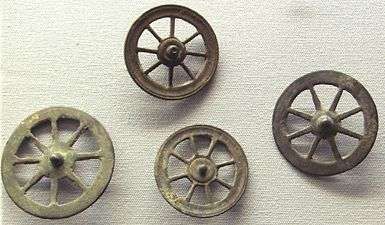Taranis

In Celtic mythology Taranis was the god of thunder worshipped primarily in Gaul, Gallaecia, the British Isles, but also in the Rhineland and Danube regions, amongst others. Taranis, along with Esus and Toutatis as part of a sacred triad, was mentioned by the Roman poet Lucan in his epic poem Pharsalia as a Celtic deity to whom human sacrificial offerings were made.[1] Taranis was associated, as was the cyclops Brontes ("thunder") in Greek mythology, with the wheel.

Many representations of a bearded god with a thunderbolt in one hand and a wheel in the other have been recovered from Gaul, where this deity apparently came to be syncretised with Jupiter.[2]
The name as recorded by Lucan is unattested epigraphically, but variants of the name include the forms Tanarus, Taranucno-, Taranuo-, and Taraino-.[3][4] The name is continued in Irish as Tuireann, and is likely connected with those of Germanic (Norse Thor, Anglo-Saxon Þunor, German Donar) and Sami (Horagalles) gods of thunder. Taranis is likely associated with the Gallic Ambisagrus (likely from Proto-Celtic *ambi-sagros = "about-strength"), and in the interpretatio romana with Jupiter.
Etymology
The reconstructed Proto-Celtic form of the name is *Toranos "thunder".[5] In present day Welsh taranu and taran means 'to thunder' and 'thunder' (taraniñ and taran in Breton).
Taranis, as a personification of thunder, is often identified with similar deities found in other Indo-European pantheons. Of these, Old Norse Þórr, Anglo-Saxon Þunor, Old High German Donar—all from Proto-Germanic *þunraz (earlier *þunaraz)—and the Hittite theonym Tarhun (see Teshub) contain a comparable *torun- element. The Thracian deity names Zbel-thurdos, Zbel-Thiurdos also contain this element (Thracian thurd(a), "push, crash down"). The name of the Sami thunder god Horagalles derives from Thor's.[6][7]
Association with the wheel

The wheel, more specifically the chariot wheel with six or eight spokes, was an important symbol in historical Celtic polytheism, apparently associated with a specific god, known as the wheel-god, identified as the sky- sun- or thunder-god, whose name is attested as Taranis by Lucan.[8] Numerous Celtic coins also depict such a wheel. It is thought to correspond to a sun-cult practiced in Bronze Age Europe, the wheel representing the sun.
The half-wheel shown in the Gundestrup "broken wheel" panel also has eight visible spokes.
Symbolic votive wheels were offered at shrines (such as in Alesia), cast in rivers (such as the Seine), buried in tombs or worn as amulets since the Middle Bronze Age.[9] Such "wheel pendants" from the Bronze Age usually had four spokes, and are commonly identified as solar symbols or "sun cross". Artefacts parallel to the Celtic votive wheels or wheel-pendants are the so-called Zierscheiben in a Germanic context. The identification of the Sun with a wheel, or a chariot, has parallels in Germanic, Greek and Vedic mythology (see sun chariot).

 Golden Celtic wheel with symbols, Balesme, Haute-Marne. Musée d'Archéologie Nationale.
Golden Celtic wheel with symbols, Balesme, Haute-Marne. Musée d'Archéologie Nationale.
Later cultural references
In 2013 a British combat drone system developed by defence contractor BAE Systems was named Taranis in reference to the Celtic god.
See also
Footnotes
- ↑ M. Annaeus Lucanus. Pharsalia, Book I
- ↑ Paul-Marie Duval. 2002. Les Dieux de la Gaule. Paris, Éditions Payot.
- ↑ Nicole Jufer & Thierry Luginbühl. 2001. Répertoire des dieux gaulois. Paris, Éditions Errance.
- ↑ Jacob Grimm, Teutonic Mythology, ch. 8: "Now with this Donar of the Germani fits in significantly the Gallic Taranis whose name is handed down to us in Lucan 1, 440; all the Celtic tongues retain the word taran for thunder, Irish toran, with which one may directly connect the ON. form Thôrr, if one thinks an assimilation from rn the more likely. But an old inscription gives us also Tanarus (Forcellini sub v.) = Taranis. The Irish name for Thursday, dia Tordain (dia ordain, diardaoin) was perhaps borrowed from a Teutonic one."
- ↑ http://www.wales.ac.uk/documents/external/cawcs/pcl-moe.pdf
- ↑ Scheffer, Johannes (1674). The History of Lapland. Oxford.
- ↑ Eesti Keele Instituut (Eesti Teaduste Akadeemia); Eesti Rahvaluule Arhiiv (1 January 2004). Folklore: electronic journal of folklore. The Institute. Retrieved 19 August 2012.
- ↑ "Symbol and Image in Celtic Religious Art".
- ↑ "Celtic Myths".
- ↑ http://www.aguarda.com/museo/index.htm
References
- Ellis, Peter Berresford, Dictionary of Celtic Mythology (Oxford Paperback Reference), Oxford University Press, (1994): ISBN 0-19-508961-8
- MacKillop, James. Dictionary of Celtic Mythology. Oxford: Oxford University Press, 1998. ISBN 0-19-280120-1.
- Wood, Juliette, The Celts: Life, Myth, and Art, Thorsons Publishers (2002): ISBN 0-00-764059-5
External links
| Look up Taranis in Wiktionary, the free dictionary. |
| Wikimedia Commons has media related to Taranis. |
- Celtic Gods and Associates
- Images of Taranis
- Celtic Gods
- Doran, Michael (August 11, 2011). "Marvel Teaser: The NEW God of Thunder? [Move Over THOR?]". Newsarama.